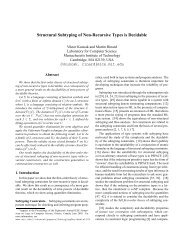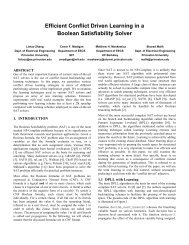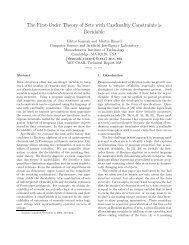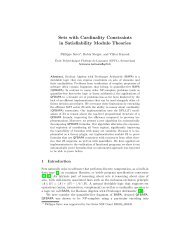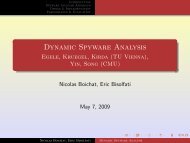6 Rümmer, Hojjat, Kuncakrelations over the universe U of a structure (U, I) ∈ S. Notions like (un)satisfiability <strong>and</strong>entailment generalise straight<strong>for</strong>wardly to <strong>for</strong>mulae with relation symbols.A relation symbol assignment is a mapping sol : R → Constr that maps each n-aryrelation symbol p ∈ R to a constraint sol(p) = C p [x 1 , . . . , x n ] with n free variables. Theinstantiation sol(h) of a <strong>Horn</strong> clause h is defined by:sol ( C ∧ p 1 (¯t 1 ) ∧ · · · ∧ p n (¯t n ) → p(¯t) ) = C ∧ sol(p 1 )[¯t 1 ] ∧ · · · ∧ sol(p n )[¯t n ] → sol(p)[¯t]sol ( C ∧ p 1 (¯t 1 ) ∧ · · · ∧ p n (¯t n ) → false ) = C ∧ sol(p 1 )[¯t 1 ] ∧ · · · ∧ sol(p n )[¯t n ] → falseDefinition 1 (Solvability). Let HC be a set of <strong>Horn</strong> clauses over relation symbols R.1. HC is called semantically solvable if <strong>for</strong> every structure (U, I) ∈ S there is aninterpretation of the relation symbols R as set-theoretic relations over U such theuniversally quantified closure Cl ∀ (h) of every clause h ∈ HC holds in (U, I).2. A HC is called syntactically solvable if there is a relation symbol assignment solsuch that <strong>for</strong> every structure (U, I) ∈ S <strong>and</strong> every clause h ∈ HC it is the case thatCl ∀ (sol(h)) is satisfied.Note that, in the special case when S contains only one structure, S = {(U, I)},semantic solvability reduces to the existence of relations interpreting R that extend thestructure (U, I) in such a way to make all clauses true. In other words, <strong>Horn</strong> clausesare solvable in a structure if <strong>and</strong> only if the extension of the theory of (U, I) by relationsymbols R in the vocabulary <strong>and</strong> by given <strong>Horn</strong> clauses as axioms is consistent.A set HC of <strong>Horn</strong> clauses induces a dependence relation → HC on R, definingp → HC q if there is a <strong>Horn</strong> clause in HC that contains p in its head, <strong>and</strong> q in thebody. The set HC is called recursion-free if → HC is acyclic, <strong>and</strong> recursive otherwise.In the next sections we study the solvability problem <strong>for</strong> recursion-free <strong>Horn</strong> clauses<strong>and</strong> then show how to use such results in general <strong>Horn</strong> clause verification systems.Definition 2 (Normal Form). A set HC of <strong>Horn</strong> clauses is in normal <strong>for</strong>m [15] iff1. every relation symbol has a unique, pairwise distinct vector of arguments,2. every non-argument variable occurs in at most one clause.5 The Relationship between Craig Interpolation <strong>and</strong> <strong>Horn</strong> <strong>Clauses</strong>It has become common to work with generalised <strong>for</strong>ms of Craig interpolation, such asinductive sequences of interpolants, tree interpolants, <strong>and</strong> restricted DAG interpolants.We show that a variety of such interpolation approaches can be reduced to recursionfree<strong>Horn</strong> clauses. Recursion-free <strong>Horn</strong> clauses thus provide a general framework unifying<strong>and</strong> subsuming a number of earlier notions. As a side effect, we can <strong>for</strong>mulatea general theorem about existence of the individual kinds of interpolants in Sect. 6,applicable to any constraint language with the (binary) interpolation property.An overview of the relationship between specific <strong>for</strong>ms of interpolation <strong>and</strong> specificfragments of recursions-free <strong>Horn</strong> clauses is given in Table 1, <strong>and</strong> will be explained inmore detail in the rest of this section. Table 1 refers to the following fragments ofrecursion-free <strong>Horn</strong> clauses:
<strong>Classifying</strong> <strong>and</strong> <strong>Solving</strong> <strong>Horn</strong> <strong>Clauses</strong> <strong>for</strong> <strong>Verification</strong> 7Form of interpolationBinary interpolation [10, 25]A ∧ BInductive interpolant seq. [20, 27]T 1 ∧ T 2 ∧ · · · ∧ T nTree interpolants [19, 24]Restricted DAG interpolants [1]Disjunctive interpolants [30]Fragment of <strong>Horn</strong> clausesPair of <strong>Horn</strong> clausesA → p( ¯x), B ∧ p( ¯x) → false with { ¯x} = fv(A) ∩ fv(B)Linear tree-like <strong>Horn</strong> clausesT 1 → p 1 ( ¯x 1 ), p 1 ( ¯x 1 ) ∧ T 2 → p 2 ( ¯x 2 ), . . .with { ¯x i } = fv(T 1 , . . . , T i ) ∩ fv(T i+1 , . . . , T n )Tree-like <strong>Horn</strong> clausesLinear <strong>Horn</strong> clausesBody disjoint <strong>Horn</strong> clausesTable 1. Equivalence of interpolation problems <strong>and</strong> systems of <strong>Horn</strong> clauses.Definition 3 (<strong>Horn</strong> clause fragments). We say that a finite, recursion-free set HC of<strong>Horn</strong> clauses1. is linear if the body of each <strong>Horn</strong> clause contains at most one relation symbol,2. is body-disjoint if <strong>for</strong> each relation symbol p there is at most one clause containingp in its body; furthermore, every clause contains p at most once;3. is head-disjoint if <strong>for</strong> each relation symbol p there is at most one clause containingp in its head;4. is tree-like [17] if it is body-disjoint <strong>and</strong> head-disjoint.Theorem 1 (Interpolation <strong>and</strong> <strong>Horn</strong> clauses). For each line of Table 1 it holds that:1. an interpolation problem of the stated <strong>for</strong>m can be polynomially reduced to (syntactically)solving a set of <strong>Horn</strong> clauses, in the stated fragment;2. solving a set of <strong>Horn</strong> clauses (syntactically) in the stated fragment can be polynomiallyreduced to solving a sequence of interpolation problems of the stated <strong>for</strong>m.5.1 Binary Craig Interpolants [10, 25]The simplest <strong>for</strong>m of Craig interpolation is the derivation of a constraint I such that A |=I <strong>and</strong> I |= ¬B, <strong>and</strong> such that fv(I) ⊆ fv(A)∩fv(B). Such derivation is typically constructedby efficiently processing the proof of unsatisfiability of A ∧ B. To encode a binaryinterpolation problem into <strong>Horn</strong> clauses, we first determine the set ¯x = fv(A) ∩ fv(B) ofvariables that can possibly occur in the interpolant. We then pick a relation symbol p ofarity | ¯x|, <strong>and</strong> define two <strong>Horn</strong> clauses expressing that p( ¯x) is an interpolant:A → p( ¯x),B ∧ p( ¯x) → falseIt is clear that every syntactic solution <strong>for</strong> the two <strong>Horn</strong> clauses corresponds to an interpolantof A ∧ B.



